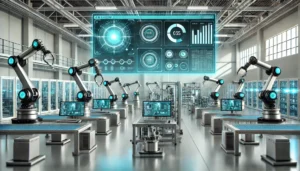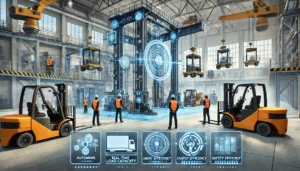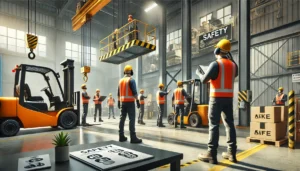Automation is changing the face of material handling equipment (MHE) deeply, drastically improving efficiency, safety, and the operational scope in almost all industries. The businesses are changing the way materials are moved, stored, and handled by utilizing automated processes.
The Development of Automated Material Handling Systems
Automated Material Handling Systems (AMHS) consists of a wide range of technologies that transport, store and control materials, typically with the least amount of human interaction necessary. This includes conveyors, automated guided vehicles (AGVs), autonomous mobile robots (AMRs), and robotic picking systems. The most important function of AMHS is improvement in efficiency, accuracy and safety for material handling systems.
Key Components of Automated Material Handling
- Automated Guided Vehicles (AGVs): Unlike traditional forklifts, automated guided vehicles are fully automated and receive commands through remote terminals. A variety of navigation equipment guides them by electronic wires, laser beams, or magnetic stripes embedded in the floor. AGVs are very helpful in warehousing and manufacturing centers as they transport materials, which in turn cuts down on human error and labor. Schooled in automotive manufacturing and warehousing industries, AGVs are efficient and highly productive.
- Autonomous Mobile Robots (AMRs): Unlike AGVs, AMRs use more sophisticated sensors and map technologies to navigate around a facility. Hence, they are capable of moving around the facility unhindered. They can modify their paths on the go to bypass obstacles and design a more efficient route, making them ideal for challenging conditions. In addition, AMRs are increasingly being deployed in e-commerce fulfillment centers so as to improve the rate at which orders are processed.
- Robotic Picking Systems: In this case computer-controlled picking arms with sophisticated vision systems are able to sort and identify products from storage. These systems are particularly useful in applications which require high precision and speed such as distribution of pharmaceuticals and even electronics manufacturing.
Benefits of Automation in Material Handling
- Enhanced Efficiency: The operation of automated systems is uncapped, meaning that there is no need to rest. This results in decreased cycle times as well as more throughput. So, for example, deploying AGVs and AMRs can increase operational efficiency due to the lack of fatigue in workers.
- Improved Safety: There is less manual work for tasks that are dangerous for employees given automated functions, meaning that the chance of injury at work is greatly reduced. The automated systems can help avoid accidents that usually accompany manual material handling, making the workplace safer.
- Cost Savings: Although adopting automation can be hard at the start with the high investments, the long-term savings in labor costs, mistakes, and increased damage to products, create overall benefits. Economically speaking, many companies have noted a positive change after using material handling automation technology.
- Scalability and Flexibility: Automated technology can be programmed to change or can be built to accommodate increased production levels as needed. This flexibility is important for companies that deal with consecutive demand as well as constant changes in material handling abilities.
Challenges and Considerations
The positive aspects of automation in material handling can sometimes be sidelined because of the challenges the automation brings to the table:
- High Initial Investment: The cost of acquiring and installing automated systems can be prohibitive for some businesses. However, the return on investment often justifies the expenditure over time.
- Integration with Existing Systems: Ensuring seamless integration between new automated equipment and existing infrastructure requires careful planning and execution. Compatibility issues can arise, necessitating modifications to current systems.
- Workforce Adaptation: The shift towards automation necessitates retraining employees to work alongside automated systems and manage new technologies. This transition can be challenging but is essential for maximizing the benefits of automation.
Future Trends in Automated Material Handling
The landscape of material handling is continually evolving, with several emerging trends:
- Integration of Artificial Intelligence (AI): AI is being incorporated into material handling systems to enable predictive maintenance, optimize routing, and enhance decision-making processes. This integration leads to smarter and more responsive systems.
- Use of Advanced Sensors and IoT: The Internet of Things (IoT) and advanced sensors are facilitating real-time monitoring and data collection, improving system responsiveness and efficiency. These technologies enable better tracking of materials and system performance.
- Development of Collaborative Robots (Cobots): Cobots are designed to work alongside human workers, enhancing productivity and safety. They are particularly useful in tasks that require a combination of human dexterity and robotic precision.
Conclusion
Automation is revolutionizing material handling equipment by introducing advanced technologies that enhance efficiency, safety, and flexibility. As businesses continue to adopt these innovations, they are poised to achieve significant improvements in their operations, positioning themselves for success in an increasingly competitive marketplace.










